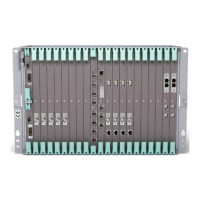System Overview
2.2 Indoor Part with subrack
AMM 20p B
AMM 6p D
10034
PFU1
M
M
U
2 B
4
-34
L
T
U
1
6
x
2
L
T
U
1
5
5
e
/o
N
P
U
1
B
AMM 2p B
02
03
02
03
M
M
U
2
E
1
5
5
NPU3
AMM 6p C
07/NPU
06
05
04
03
02
08/FAU2
01/PFU3
00/PFU3
M
M
U
2
E
1
5
5
M
M
U
2
F
1
5
5
NPU3
E
1
/
D
S
1
E
1
/
D
S
1
LTU3 12 1
E
1
/
D
S
1
PFU3
PFU3
F
AU2
07/NPU
06
05
04
03
02
08/FAU2
01/PFU3
00/PFU3
PFU3
PFU3
FAU2
M
M
U
2
E
1
5
5
M
M
U
2
F
1
5
5
NPU3
E
1
/
D
S
1
E
1
/
D
S
1
L
TU3 12 1
E
1
/
D
S
1
Figure 4 Subracks
The AMM is a subrack.
The indoor part consists of an Access Module Magazine (AMM) with plug-in
units interconnected through a backplane. One plug-in unit occupies one slot in
the subrack. The subrack fits into standard 19" or metric racks.
The following text introduces the standard indoor units and their main functions.
For each unit there exist several types with different properties, further
described in Section 3 on page 9 and Section 4 on page 67.
Access Module Magazine
(AMM)
The AMM houses the plug-in units and
provides backplane interconnection of
traffic, power and control signals.
Node Processor Unit (NPU)
The NPU handles the system’s control
functions. It also provides traffic and
management interfaces.
Line Termination Unit (LTU)
The LTU provides PDH or SDH traffic
interfaces.
Modem Unit (MMU)
The MMU constitutes the indoor part of a
Radio Terminal. It determines the traffic
capacity and modulation scheme.
Ethernet Interface Unit (ETU) The ETU provides Ethernet traffic
interfaces.
5
12/221 02-CSH 109 32/1-V1 Uen A 2008-03-14

